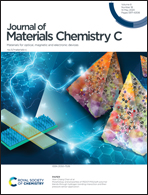A vitrified film of an anisometric europium(iii) β-diketonate complex with a low melting point as a reusable luminescent temperature probe with excellent sensitivity in the range of 270–370 K†
Abstract
A novel temperature probe with −1.0% K−1 mean relative and −5.4 μs K−1 mean absolute sensitivity of the luminescence decay time in the range of 270–370 K is presented. The probe is a 20 μm thick vitrified film (sandwiched between two quartz plates) fabricated from an amorphous powder of an anisometric europium(III) β-diketonate complex through a melt-processing technique. It is established that the film exhibits bright Eu3+ ion luminescence with the most intense peak at 611 nm caused by efficient ligand-to-metal energy transfer. The observed thermal luminescence sensitivity we associate with a well-known non-radiative relaxation mechanism of the Eu3+ ions through the low-lying ligand-to-metal charge transfer state. The experiments also showed that (i) the luminescence of the film is insensitive to oxygen, (ii) the film is completely resistant to UV-vis light, (iii) there is full reversibility of the temperature dependent luminescence decay time, and (iv) the strong luminescence of the film can be efficiently excited by irradiation in the wavelength range of 280–425 nm (including inexpensive and portable blue-violet light sources). The listed facts allow us to consider the film as a promising probe for reusable luminescent thermometers, suitable for long-term temperature monitoring.



 Please wait while we load your content...
Please wait while we load your content...